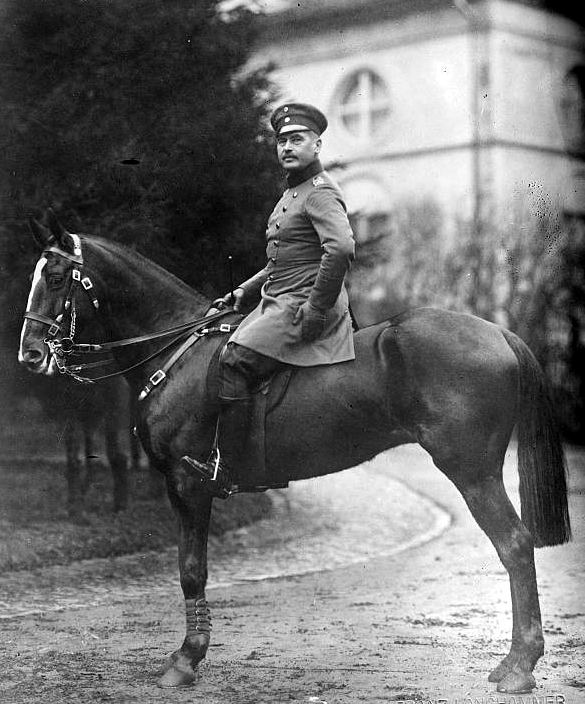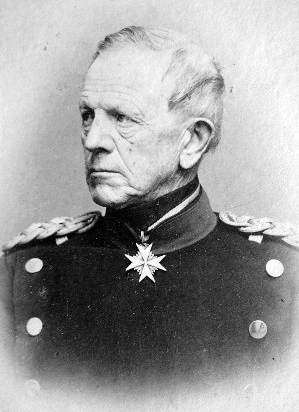|
Otto Liman Von Sanders
Otto Viktor Karl Liman von Sanders (; 17 February 1855 – 22 August 1929) was an Imperial German Army general who served as a military adviser to the Ottoman Army during the First World War. In 1918 he commanded an Ottoman army during the Sinai and Palestine Campaign. On the whole Sanders provided only limited help to the Ottoman forces. Early life and career Otto Liman was born in Stolp (now Słupsk, Poland) in the Province of Pomerania in the Kingdom of Prussia. He was the son of Carl Leonhard Liman and his wife Emma née Michaelis. Carl Liman was a prosperous businessman, who purchased the lordship of the manor (Rittergut) of Schwessin (now Świeszyno, Poland). Although divergent details of Carl Liman's paternal ancestry are recorded, it is generally agreed that his father and Otto's grandfather was born to a Jewish family by the name of Liepmann and was later baptised a Christian. After gaining his diploma (Abitur) at the Friedrich Wilhelm Gymnasium in Berlin, Otto Lim ... [...More Info...] [...Related Items...] OR: [Wikipedia] [Google] [Baidu] |
Province Of Pomerania (1815–1945)
The Province of Pomerania (german: Provinz Pommern; pl, Prowincja Pomorze) was a Provinces of Prussia, province of Prussia from 1815 to 1945. Pomerania was established as a province of the Kingdom of Prussia in 1815, an expansion of the older Brandenburg-Prussia province of Province of Pomerania (1653–1815), Pomerania, and then became part of the German Empire in 1871. From 1918, Pomerania was a province of the Free State of Prussia until it was dissolved in 1945 following World War II, and its territory divided between Poland and Allied-occupied Germany. The city of Szczecin, Stettin (present-day Szczecin, Poland) was the provincial capital. Etymology The name ''Pomerania'' comes from Slavic languages, Slavic , which means "Land at the Sea". Overview The province was created from the Province of Pomerania (1653–1815), former Prussian Province of Pomerania, which consisted of Farther Pomerania and the southern Western Pomerania, and former Swedish Pomerania. It resembled t ... [...More Info...] [...Related Items...] OR: [Wikipedia] [Google] [Baidu] |
German General Staff
The German General Staff, originally the Prussian General Staff and officially the Great General Staff (german: Großer Generalstab), was a full-time body at the head of the Prussian Army and later, the German Army, responsible for the continuous study of all aspects of war, and for drawing up and reviewing plans for mobilization or campaign. It existed unofficially from 1806, and was formally established by law in 1814, the first Staff (military), general staff in existence. It was distinguished by the formal selection of its officers by intelligence and Merit system, proven merit rather than patronage or wealth, and by the exhaustive and rigorously structured training which its staff officers undertook. Its rise and development gave the German armed forces a major strategic advantage over their adversaries for nearly a century and a half. The Prussian General Staff also enjoyed greater freedom from political control than its contemporaries, and this autonomy was enshrined in ... [...More Info...] [...Related Items...] OR: [Wikipedia] [Google] [Baidu] |
Oberleutnant
() is the highest lieutenant officer rank in the German-speaking armed forces of Germany ( Bundeswehr), the Austrian Armed Forces, and the Swiss Armed Forces. Austria Germany In the German Army, it dates from the early 19th century. Translated as "senior lieutenant", the rank is typically bestowed upon commissioned officers after five to six years of active-duty service. is used by both the German Army and the German Air Force. In the NATO military comparison system, a German is the equivalent of a First lieutenant in the Army/Air Forces of Allied nations. ;Other uses The equivalent naval rank is '' Oberleutnant zur See''. In Nazi Germany, within the SS, SA and Waffen-SS, the rank of Obersturmführer was considered the equivalent of an in the German Army. National People's Army In the GDR National People's Army (NPA) the rank was the highest lieutenant rank, until 1990. This was in reference to Soviet military doctrine and in line with other armed ... [...More Info...] [...Related Items...] OR: [Wikipedia] [Google] [Baidu] |
Prussian Military Academy
The Prussian Staff College, also Prussian War College (german: Preußische Kriegsakademie) was the highest military facility of the Kingdom of Prussia to educate, train, and develop general staff officers. Location It originated with the ''Akademie für junge Offiziere der Infanterie und Kavallerie'' (Academy for young officers of the infantry and cavalry) in 1801, later becoming known as the Allgemeine Kriegsschule (General War-School). It was officially re-founded by Gerhard von Scharnhorst in Berlin on October 15, 1810 as one of three officer colleges. Its building on Unter den Linden (1845/25), Berlin, was designed by Karl Friedrich Schinkel. Graduation Graduating from the ''Staff College'' was a prerequisite for appointment to the ''Prussian General Staff'' (later the German General Staff). Carl von Clausewitz enrolled as one of its first students in 1801 (before it was renamed), while other attendees included Field Marshals von Steinmetz, von Moltke, and von Blument ... [...More Info...] [...Related Items...] OR: [Wikipedia] [Google] [Baidu] |
Fahnenjunker
''Fahnenjunker'' (short Fhj or FJ, en, officer cadet; ) is a military rank of the Bundeswehr and of some former German armed forces. In earlier German armed forces it was also the collective name for many officer aspirant ranks. It was established by the ''Presidential order of the Federal president on rank insignia and uniforms of soldiers''.The Federal president (publisher): Order of the Federal president (de: Bundespräsident) on rank insignia and uniform of soldiers (short title: BPräsUnifAnO), issued July 14, 1978. Rank ''Fahnenjunker'' is the entrance rank to an officer aspirant career. According to the salary class, it is equivalent to the Unteroffizier ohne Portepee ranks Unteroffizier of the army or air force, and Maat of the Deutsche Marine. It is also grouped as OR-5 in NATO, equivalent to Sergeant, Staff Sergeant in the US Armed forces. In the army context, NCOs of this rank were formally addressed as ''Herr/ Frau Fahnenjunker'' also informally / short ''Fahnenju ... [...More Info...] [...Related Items...] OR: [Wikipedia] [Google] [Baidu] |
Friedrich Wilhelm Gymnasium
The Friedrich Wilhelm Gymnasium (or Friedrich-Wilhelms-Gymnasium) was a secondary school ( ''Gymnasium'') in Berlin. History The school originated from a Realschule founded by the Pietist Johann Julius Hecker in 1747, the first secondary school in Berlin. On its 50th anniversary in 1797, the school was renamed after Friedrich Wilhelm III, who had succeeded his father as King of Prussia earlier in that year, and wanted to improve the successful secondary school. He gave additional funds for an additional building to house the expanded school. The Friedrich Wilhelm Gymnasium buildings were located on Kochstrasse in Berlin's Friedrichstadt district. In: C. F. Wegener: Haus- und General-Adreßbuch der Königl. Haupt- und Residenzstadt Berlin, 1822, Part 3, p. 85. (in German) The grammar school was located on Kochstrass ... [...More Info...] [...Related Items...] OR: [Wikipedia] [Google] [Baidu] |
Abitur
''Abitur'' (), often shortened colloquially to ''Abi'', is a qualification granted at the end of secondary education in Germany. It is conferred on students who pass their final exams at the end of ISCED 3, usually after twelve or thirteen years of schooling (see also, for Germany, ''Abitur'' after twelve years). In German, the term has roots in the archaic word , which in turn was derived from the Latin (future active participle of , thus "someone who is going to leave"). As a matriculation examination, ''Abitur'' can be compared to A levels, the '' Matura'' or the International Baccalaureate Diploma, which are all ranked as level 4 in the European Qualifications Framework. In Germany Overview The ("certificate of general qualification for university entrance"), often referred to as ("''Abitur'' certificate"), issued after candidates have passed their final exams and have had appropriate grades in both the last and second last school year, is the document which cont ... [...More Info...] [...Related Items...] OR: [Wikipedia] [Google] [Baidu] |
Świeszyno, Pomeranian Voivodeship
Świeszyno (; german: Schwessin) is a village in Gmina Miastko, Bytów County, Pomeranian Voivodeship, in northern Poland. It lies approximately south-west of Bytów and south-west of Gdańsk (capital city of the Pomeranian Voivodeship). From 1975 to 1998 the village was in Słupsk Voivodeship Słupsk Voivodeship. was a unit of administrative division and local government in Poland from 1975 to 1998, previously part of Szczecin Voivodeship (1945–50) and Koszalin Voivodeship (1950–75), superseded (since 1999) by Pomeranian Voivodesh .... It has a population of 152. References *Map of the Gmina Miastko Villages in Bytów County {{Bytów-geo-stub ... [...More Info...] [...Related Items...] OR: [Wikipedia] [Google] [Baidu] |
Ottoman Army
The military of the Ottoman Empire ( tr, Osmanlı İmparatorluğu'nun silahlı kuvvetleri) was the armed forces of the Ottoman Empire. Army The military of the Ottoman Empire can be divided in five main periods. The foundation era covers the years between 1300 (Byzantine expedition) and 1453 ( Conquest of Constantinople), the classical period covers the years between 1451 (second enthronement of Sultan Mehmed II) and 1606 (Peace of Zsitvatorok), the reformation period covers the years between 1606 and 1826 ( Vaka-i Hayriye), the modernisation period covers the years between 1826 and 1858 and decline period covers the years between 1861 (enthronement of Sultan Abdülaziz) and 1918 (Armistice of Mudros). The Ottoman army is the forerunner of the Turkish Armed Forces. Foundation period (1300–1453) The earliest form of the Ottoman military was a steppe-nomadic cavalry force.Mesut Uyar, Edward J. Erickson, ''A Military History of the Ottomans: From Osman to Atatürk'', Pleage ... [...More Info...] [...Related Items...] OR: [Wikipedia] [Google] [Baidu] |
Military Adviser
Military advisors, or combat advisors, advise on military matters. Some are soldiers sent to foreign countries to aid such countries with their military training, organization, and other various military tasks. The Foreign powers or organizations may send such soldiers to support countries or insurgencies while minimizing the risks of potential casualties and avoiding the political ramifications of overtly mobilizing military forces to aid an ally. European advisors during the American Revolution The French Marquis de Lafayette and the German/Prussian Baron von Steuben offered key assistance to the Continental Army during the American Revolutionary War of 1775–1783. Soviet military advisors The Soviet Union deployed military advisors in (for example) Spain, China and Angola, where "The 1976 treaty of friendship and cooperation provided for Soviet-Angolan military cooperation in strengthening the mutual defense capacity. Moscow immediately provided weaponry and supplies, a ... [...More Info...] [...Related Items...] OR: [Wikipedia] [Google] [Baidu] |
Imperial German Army
The Imperial German Army (1871–1919), officially referred to as the German Army (german: Deutsches Heer), was the unified ground and air force of the German Empire. It was established in 1871 with the political unification of Germany under the leadership of Prussia, and was dissolved in 1919, after the defeat of the German Empire in World War I (1914–1918). In the Federal Republic of Germany, the term ' identifies the German Army, the land component of the '. Formation and name The states that made up the German Empire contributed their armies; within the German Confederation, formed after the Napoleonic Wars, each state was responsible for maintaining certain units to be put at the disposal of the Confederation in case of conflict. When operating together, the units were known as the Federal Army ('). The Federal Army system functioned during various conflicts of the 19th century, such as the First Schleswig War from 1848–50 but by the time of the Second Schles ... [...More Info...] [...Related Items...] OR: [Wikipedia] [Google] [Baidu] |



